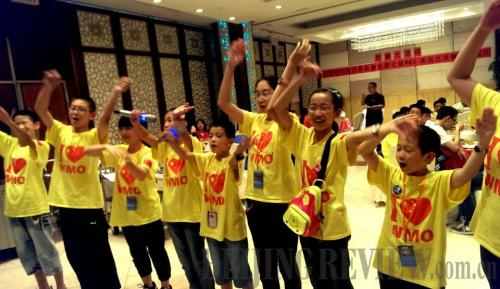|
 |
|
The students participating the Seventh World Mathematics Olympiad (WMO) come from all corners of China and various schools in the New York City greater metropolitan region (FILE) |
Mathematics is a universal language, it is said, and it is one of the world's very few constants. One plus one always equals two -- and sharing one culture with another culture always multiplies, and never divides.
Cultural understanding and a lot of math-based fun were the aims of the Seventh World Mathematics Olympiad (WMO), hosted at Columbia University on August 20. The event brought together approximately 90 students, aged 10 to 16, from around China and the New York City area to participate in competition and other group activities. The all-day event was held at the university's Schermerhorn Hall and was co-organized by the China National Committee for the Wellbeing of the Youth (NCWY) and Columbia educators.
The student participants were quite diverse, coming from all corners of China and various schools in the New York City greater metropolitan region. Along with many other New York City schools, were students from P.S. 124 Yung Wing School, located in Manhattan's Chinatown, named for the first Chinese student to graduate from an American university.
To open the event, Dr. Nick Wasserman, Assistant Professor in the department of Mathematics, Science and Technology at Teachers College, Columbia University, gave the opening keynote speech on importance of math education and how to engage students in the subject.
"Math education is about creativity, it's about designing," said Wasserman. "Students need tasks that are engaging, and that engage them in reasoning and meaningful problem solving."
While illustrating how to engage with mathematics, the professor presented the students with some complex, yet fun, math questions, which could not be solved with an obvious answer, or what he called a "cognitive conflict." Some of the students managed to correctly answer the presented puzzles and all were quite enthused during the presentation.
The second keynote speaker for the event was Jian Liu, math teacher at Clara Barton High School and a Math for America Fellow. Liu, who also helped translate many of the day's events, spoke about his personal journey from China to the U.S. He said he knew very little English before arriving in New York, but soon excelled in his studies and especially in mathematics.
"Personally, I think mathematics is the foundation for all other subjects. A lot of things can be explained by using mathematical models," said Liu. "Learning math is not just about doing computation, but also learning about logical and critical thinking as well as communication, in a particular language which is mathematical language."
At the conclusion of the speeches by Wasserman and Liu, the students began the testing competition. Participants had 90 minutes to complete an exam that covered various mathematical concepts and areas. Students were given exams to correspond with their grade levels and language preference (Chinese students took the test in Mandarin and American students took the English test). The exam questions were quite challenging and pushed students beyond their normal schooling curriculum.
Nancy Ko, organizer and host of the Olympiad, stated that the participants were some of the top students from their respective schools, as the exams were created to provide an interesting challenge for such students. She also said that the event was especially beneficial for Chinese participants, who travelled across the world to take part in the competition.
"We believe that the Olympiad is an interoperable international friendship platform to enhance the emotional and cultural exchanges," said Ko. "[This competition has] helped many Chinese students learn innovative thinking and practical abilities to deepen ties between mathematics and life."
After the exam, students broke for lunch and were encouraged to meet their peers from across the world. Many of the students were shy at first, not venturing out of their comfort zones. Yet, by day's end, most of the students were intermingling, a rare opportunity for both the American and Chinese sides.
The event was not only a serious exam, but also the organizers made sure to provide plenty of educational and engaging activities. The students were split into groups and given various tasks for the afternoon, which could only be completed if group members worked together. The first activity that the students were tasked with was to create a trophy from various materials provided to them, which would be judged on the basis of creativity and effort. The judges consisted of local teachers, volunteer staff from Columbia, and NCWY representatives.
"I try to get some tasks that relate to students experiences from things they learned before or from their social life. When students can make connection, it is not only fun, but also [they] understand the concept better," said Liu, who led the second half of the day's events. "Learning mathematics is about learning certain skills, such as, gathering information, translate from English sentences into mathematical language by using symbols and numbers. Other skills may also include computation, visual representation, understand geometric shapes."
The students and their group members then raced to complete several challenging math games. Each game challenged the students with a different kind of conceptual math puzzle.
The NCWY has been organizing these Olympiads over the past six years and there have been approximately nine million participants worldwide. The competition prior to the Columbia event took place at the UK's Cambridge University, where students came from all corners of the globe to compete.
"Through the contest, we are spreading the latest information and advanced mathematics education and teaching to countries, in order to enhance exchanges and cooperation between mathematics educators, and ultimately, to vigorously promote the development of mathematics education," said Ko.
The next competition will be held at Stanford University in February 2015, continuing the tradition of elite host institutions. The organizers host the Olympiad in varying geographic locales to ensure a great diversity of student participation.
The author is a contributing writer to Beijing Review | 